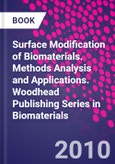Part one begins with chapters looking at various types and techniques of surface modification including plasma polymerisation, covalent binding of poly (ethylene glycol) (PEG), heparinisation, peptide functionalisation and calcium phosphate deposition before going on to examine metal surface oxidation and biomaterial surface topography to control cellular response with particular reference to technologies, cell behaviour and biomedical applications. Part two studies the analytical techniques and applications of surface modification with chapters on analysing biomaterial surface chemistry, surface structure, morphology and topography before moving onto discuss modifying biomaterial surfaces to optimise interactions with blood, control infection, optimise interactions with soft tissues, repair and regenerate nerve cells, control stem cell growth and differentiation and to optimise interactions with bone.
The distinguished editor and international team of contributors to Surface modification of biomaterials have produced a unique overview and detailed chapters on a range of surface modification techniques which will provide an excellent resource for biomaterials researchers and scientists and engineers concerned with improving the properties of biomaterials. It will also be beneficial for academics researching surface modification.








